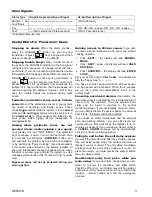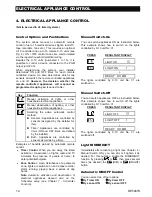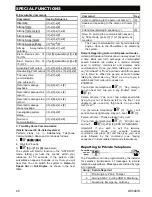
INTRODUCTION
DE5467U
5
The system identifies a wide range of events -
alarms, attempts to tamper with sensors and several
types of trouble. Events are automatically reported
via the public telephone network or GSM network to
central monitoring stations (in digital form) and to
private telephones (in plain language and/or SMS
messages). The person receiving such a message is
expected to investigate the event and act
accordingly.
IMPORTANT! All you need to know to secure your
premises can be found in Chapter 2 of this manual.
If you are not familiar with some of the terms
used here, refer to Appendix A at the end of this
guide.
System Features
Your P offers a large number of unique
features:
•
30 zones:
Each protected zone is identified by
number and by name (ask your installer to
assign names to your zones).
•
Multiple arming modes:
AWAY, HOME,
AWAY-INSTANT, HOME-INSTANT, LATCHKEY
and BYPASS.
•
Liquid crystal display (LCD):
Plain-
language status information and prompts are
displayed on the front panel in large, clear
letters.
•
Real-time clock:
The present time is visible
on the right side of the display.
•
Various reporting destinations:
Events
are reported automatically to central monitoring
stations, private telephones of your choice and
even to a pager.
•
Selective reporting:
Your installer can
determine what type of event will be reported to
which destination.
•
Latchkey mode:
An automatic “Latchkey”
message is sent to chosen telephones if the
system is disarmed by a “latchkey” user (a junior
family member, for instance).
•
Spoken announcements and
instructions:
Status-dependent, pre-recorded
verbal messages are heard over the built-in
loudspeaker (if the voice prompts are enabled -
see Chapter 7 - Setting the Voice Options).
•
Message exchange:
Before leaving the
premises, you may record a short verbal
message for other users of the system who may
arrive later. Upon arrival, you can listen to verbal
messages left by others for you.
•
Keypad and wireless control:
Full control
from the keypad; major functions can be carried
out by pressing buttons on hand-held miniature
transmitters.
•
Access from remote telephones:
You may
access the P from a remote telephone
and Arm/Disarm it or receive system status
information.
•
Numerical keys serve as function keys:
In the disarmed state, numerical keys are used
to control various system functions. A simple
icon on each key identifies the task of that key.
•
Electrical device control:
Lights and
electrical appliances can be controlled if optional
X-10 modules are used. The electrical cabling
network of the building carries the control
signals. Your installer will determine the control
means in accordance with your needs.
•
PGM remote control:
Gate control
mechanisms, courtesy lights and various other
devices can be switched on and off via a special
PGM (programmable) output. Your installer will
determine the control means, in accordance with
your needs.
•
Data retrieval:
You can obtain status
information, trouble information and review
memorized alarm events - visually and verbally.
•
Looking after elderly, physically
handicapped and infirm individuals (not
used in UL-listed systems):
The system
can be programmed to monitor activity within the
protected area and send out an alert message if
the person under surveillance remains still for
too long.
•
Distress calls:
Miniature pushbutton
transmitters given to specific individuals may be
used for sending emergency calls for help.
•
Disarming under duress:
If a user is forcibly
compelled to disarm the system, he can use a
special code that disarms the system apparently
as usual, but sends a silent alarm to the central
station (see Chapter 2 - Disarming and Stopping
Alarms, Disarming Under Duress).
•
System supervision:
All wireless detectors
and wireless commanders within the protected
site send periodic supervision messages. If such
a message is overdue, the P displays
an ‘inactivity’ trouble message. Your installer
can disable this feature if so desired.
•
Battery supervision:
You do not have to
worry about ‘dead’ batteries. The P
displays a ‘Low Battery’ message whenever a
battery in a wireless device is found to be near
the end of its useful life.







































